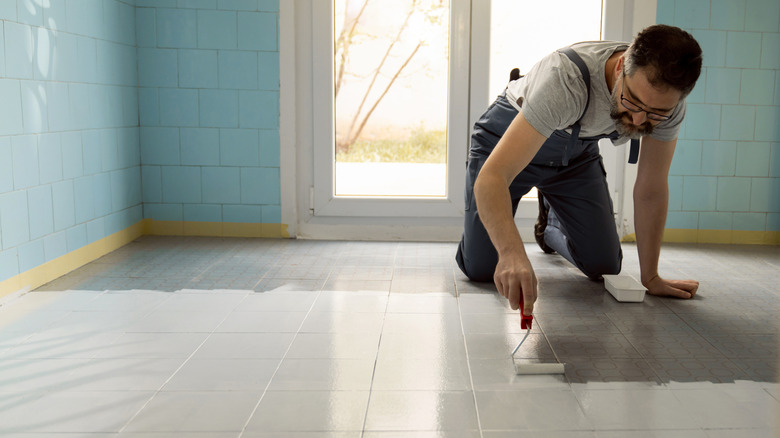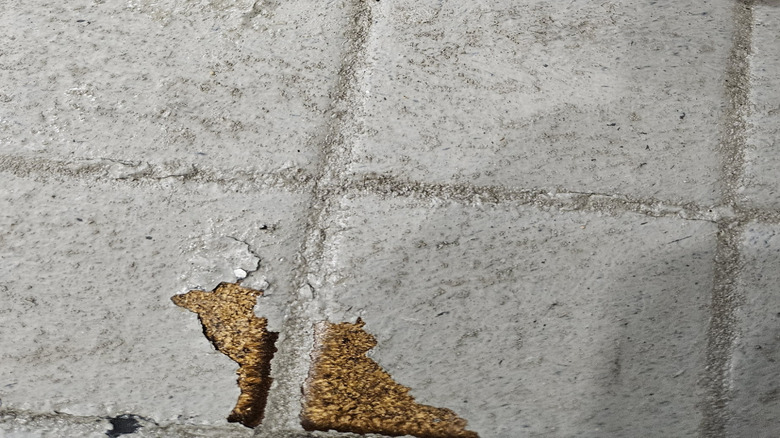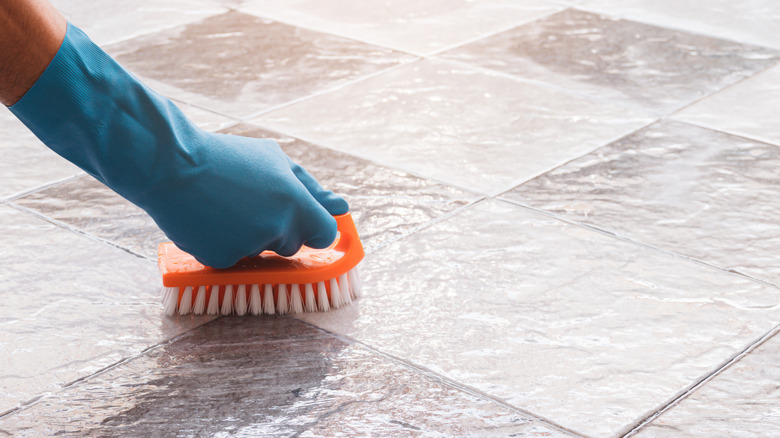Drawbacks To Consider Before Painting Tile Floors (And What We'd Try Instead)
Porcelain and ceramic tiles are known for their incredible durability, and are able to last for decades thanks to their super hard, non-porous makeup. On the other hand, this also means it can be really difficult to remove tile flooring, requiring you to essentially break them apart with brute force. This something many homeowners struggle with, because sadly, tile flooring styles frequently go in and out of fashion. In the early 2000s, for instance, Tuscan-style kitchens were all the rage, and many included a beige, textured porcelain tile with tan grout. Then in the early 2010s when farmhouse modern became the style du jour, people had to rip these unfashionable tiles out, which required a ton of backbreaking labor and expensive modifications. To make life easier, some have decided to skip removing tile floors the correct way, and simply paint over them. The solution seems easy enough — painting a floor is a budget-friendly way to give your floors an upgrade, and it doesn't require significant prep work or know-how, but this may not be the best choice in the long term.
With any new home decor trend, we don't know how it will last over time, nor up to wear and tear, which flooring sees a lot of. Painted tile floors may look bad quickly and be difficult to maintain, and that's if you can even get the paint to properly adhere in the first place.
How painted tiles can go wrong
Tile floors do so well against the test of time because they are incredibly hard, non-porous, and smooth. That's great for durability, but typically, paint doesn't adhere well to smooth, non-porous surfaces. Ben Napier of HGTV's "Home Town" expressed his doubt about the paint trend, saying, "I don't know how it would adhere to a porcelain tile," (via Real Simple). A primer can help somewhat so the paint has something to grip onto, as well as a specialty paint made for tile, but there's still no guarantee the paint will fully adhere.
The other issue is that once you get it onto the tile, it may not stay flat. Many of the rooms we use tile floors in are also subject to humidity and hot temperatures — like the kitchen and bathroom. Subjected to both, paint has a tendency to lift, bubble, and peel away. If you thought your old tile floors looked shabby, imagine how they'll look peeking through a few layers of peeling paint. Scuffs, bubbling, and so many other issues regularly show up on painted walls, so consider what happens to paint that is stepped on by dirty shoes and pet paws day in and day out.
In addition to showing imperfections, you'll likely notice signs of uneven wear in spaces that are subject to more foot traffic. This can cause discoloration and deteriorate the paint. Once these issues arise, you're then faced with either removing the paint (which may be stuck unevenly between the porous grout and tiles), or repainting the tiles, which means that area is off-limits. Basically, painting your floors makes for a logistical nightmare.
Refreshing your tile floors without replacing or painting them
If you really can't stand to look at your tile floors as they are, there are still good options for changing their look that don't require a bucket of paint. First, try to give your tile floors a really thorough cleaning. Often, the thing that makes tiles look dated and icky is that they are actually dirty. After sweeping or vacuuming the floor, hit it with some specialty tile floor cleaner and do some old fashioned hands-and-knees cleaning with a scrub brush. After, clean the grout thoroughly — you may be surprised to find that the grey or beige color is actually a nice clean white, instantly improving the look of your floors. If all else fails, try to remove and replace your grout. This small refresh can make a huge difference in the overall appearance of your tile floors.
Using peel-and-stick tiles is another solid choice. Peel-and-stick tiles are easy to install, affordable, and removable, making them a quick and cost-effective way to refresh your floors. Unlike paint, which can chip, peel, or wear unevenly, peel-and-stick tiles are designed to withstand daily wear and tear. Some are even designed to withstand use in hot, humid rooms like bathrooms and kitchens. There's essentially no end of available patterns, colors, and even textures available in the peel-and-stick category, so you can find one that fits your unique design sense. Best of all, peel-and-stick tiles are removable and replaceable, so you can try out several options, and simply remove them when you're ready to try something else.


